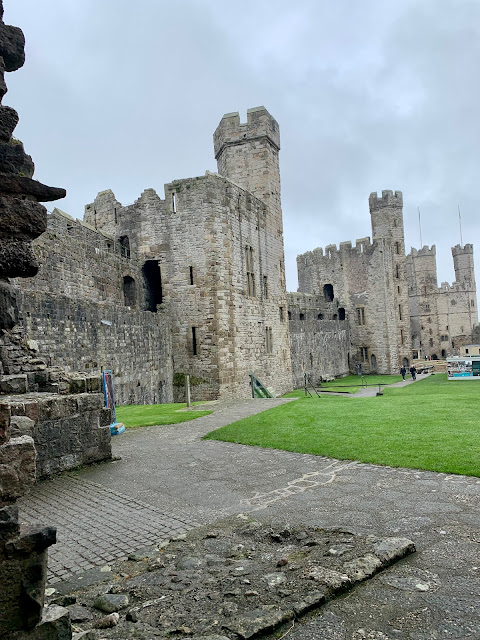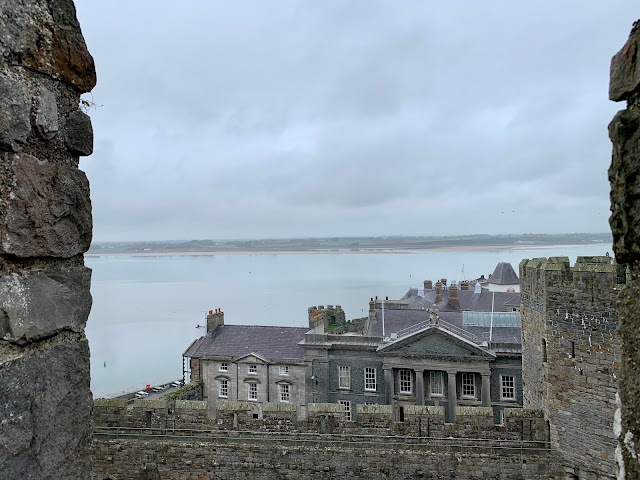In October 2021, we finally ticked off another Welsh castle and went to visit the beautiful Caernarfon Castle. She was the third castle for the Castle Casanovas and technically Alex was on board as I was 7 months pregnant at the time. I personally don't recommend visiting any castles whilst heavily pregnant, because as I found out climbing stairs, doing lots of walking and standing to read things (I happily would have murdered Steve in The Royal Welch Fusiliers Museum) is very strenuous and will result in extreme Braxton hicks...
I have fond memories of visiting Caernarfon when I was little and I always remember the exhibits being really interesting with a lot to do and see. Caernarfon Castle has, obviously, moved on since then and is now filled with even more exhibitions, information and fun things to do with the little ones.
History
The first 'castle', well fortress, built at Caernarfon was built by the Romans and named Segontium. Following the Norman Conquest of England, a small castle was built by Hugh d'Avranches (the Earl of Chester) and it was one of three castles built to reassert Norman control in Wales. This was built on the peninsula and was likely to be a Motte and Bailey castle.
In 1282, war broke out again in Wales and Edward I decided to build castles to strengthen his position. He chose to build castles at Harlech and Caernarfon. Apparently, during the construction of Caernarfon the body of Roman emperor Magnus Maximus was found and reburied in a local church.
Caernarfon is a part of three castles that were built by the master mason James of Saint George. A visionary of his time who created beautiful castles with allegedly incredible defence power. It is believed the timbers came from around the country (Liverpool included) and the stone was quarried locally from around Anglesey.
In 1285, the town walls were mostly completed and works continued at the castle. In 1294, a rebellion broke out and the Welsh targeted Caernarfon as it was a symbol of English power. Madog's forces captured the town and heavily damaged the town walls. The castle was also quickly taken, as it was defended by a simple barricade and ditch, and set alight. By 1295, the English had control of Caernarfon and began to refortify the town. Once the rebellion was dampened, Edward began to build Beaumaris (you can read about our visit to Beaumaris here). As a result of this, a new master mason, Walter of Hereford, was brought in to oversee the works at Caernarfon.
There is a gap in building between 1301 and 1304, which is believed to be due to the Scottish wars and labour needing to move up to defend England. Construction begins again in late 1309 and Walter sadly died in 1309, never seeing the completed castle. Henry of Ellerton took over as master mason and work continued at a good pace until 1330. Building from 1284 to 1330 is believed to have cost around £20,000 to £25,000, which was an enormous sum and took funding away from places such as Dover.
What is left of the castle is mostly from the Edwardian period. A lot of the planned works at Caernarfon were never carried out and even the kings and queens gate were left unfinished.
For two centuries after the Norman Conquest, Caernarfon remained a military base and was effectively the capital of North Wales. It appears that English and Welsh tensions continued to rise, due to the English discriminating and refusing to give high jobs in the administration to Welsh people. This spilled over into the 15th Century and the Glyndŵr Rising broke out and continued until 1415. Caernarfon was of course targeted and besieged by Welsh troops who were supported by the French. Interestingly, the Tudor dynasty apparently dampened tensions as the Tudors were Welsh in origin and this went a way to healing the rift between the two countries. Caenaerfon Castle was effectively abandoned and by 1538 many Welsh castles were just left empty.
The town walls remained in good condition and were up-kept, however the castle was left to ruin. The castles defences remained in such good condition that it was actually used by Royalists during the English Civil War. Of course, it had been stripped of anything valuable and had no glass windows and limited roofing. It was surrendered back to Parliamentarians in 1646. This was the last time Caernarfon castle saw fighting. In 1660, it was allegedly ordered that Caernarfon castle and its town walls be pulled down, although works appears to have been abandoned early on.
Caernarfon castle remained abandoned until the 1870s when the Government took interest and ordered repairs. Llewellyn Turner was the man who oversaw the work and went a bit beyond his orders of just repairing the stonework as he controversially began rebuilding and restoring the castle. In 1911, Caernarfon castle was used for the investiture of the Prince of Wales (Prince Edward).
In 1969, the precedent was continued with the investiture of Prince Charles (now King) as the Prince of Wales. If you haven't watched the episode of The Crown that deals with Prince Charles investiture I highly recommend you watch it - it is very good! The title of Prince of Wales is commonly given to the eldest Son of the reigning monarch. It is understood that Prince William will become the next Prince of Wales, with Catherine becoming the Princess of Wales (a bit controversial given a lot of people feel the title should be retired after Princess Diana's sad death).
Whilst Caernarfon castle is the property of the Crown it is cared for CADW, and you all know I love a castle that is maintained by CADW (because they're generally really good!). In 1986, the castle was granted a World Heritage Site and it now also houses the Royal Welch Fusiliers museum, which really is great!
Our visit
We visited Caernarfon Castle in October 2021, whilst I was 7 months pregnant. It took us around 40 minutes in the car and we planned to have a full day out there. The castle takes around two and a half hours to do from start to finish, which includes the exhibits and the fusiliers museum.
I didn't get to go up the towers for fear of falling, but I did get to explore most of the castle as it is fairly accessible for all and relatively flat. I really enjoyed the castle as it was very nostalgic and reminded me of visits when I was a child. There was a lot to see and the castle is in really good condition. It is restored, but restored very well so much so it still looks like a medieval castle (not like some castles where they have been restored into stately homes).
The exhibits were really interesting and there was so much to read and learn. I would say the exhibits were interactive enough to keep children entertained, but they'd probably have the most fun climbing the towers and seeing the castle walls.
We had a lovely time and enjoyed exploring the lovely town of Caernarfon as well. We even visited one of the oldest inns and had some wonderful food, which was the perfect way to end the day.
Opening Times:
1 March - 30 June - 9:30am to 5:00pm
1 July - 31 August - 9:30am to 6:00pm
1 September - 31 October - 9:30am to 5:00pm
1 November - 28 February - 10:00am to 4:00pm (closed 24th, 25th, 26th December and 1 January)
Last admission is 30 minutes before closing for all dates.
Prices:
Member: Free ; Adult: £11.10 ; Family (2 adults and 3 children): £36.60 ; Juniors aged 5-17, NUS, Armed Forces and Veterans: £7.80 and Seniors: £10.60.
The challenge:
This was castle number three in our challenge and the second Welsh castle we visited! We were still a long way off completing the challenge as a whole, but we were enjoying the process and really looking forward to the next castles we could visit and see.
At this stage the challenge was 0.6% complete overall and the welsh castles were 3.4% complete.
Don't forget to keep up with the challenge via our social media channels (linked below) and check back for more updates in the Castle Casanovas tab!
Until Next Time
The Castle Casanovas
.......................................
Other posts you may be interested in:
- Castle One: Beaumaris
- Castle Two: GoodRich Castle











Add your comment